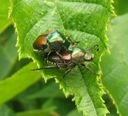Popillia
Popillia
Classification
- Phylum: Arthropoda
- Subphylum: Hexapoda
- Class: Insecta
- Order: Coleoptera
- Suborder: Polyphaga
- Superfamily: Scarabaeoidea
- Family: Scarabaeidae
- Subfamily: Rutelinae
- Tribe: Anomalini
- Genus: Popillia
Pronunciation
How to pronounce Popillia: /pɔˈpɪ.li.a/
These audio files are automatically generated. While they are not always 100% accurate, they are a good starting point.
Images






Summary
Popillia is a genus of scarab beetles, with the Japanese beetle being the most notable species. They play an important role in the ecosystem but are also significant agricultural pests responsible for crop damage.
Physical Characteristics
Base of pronotum tri-emarginate; pygidium and abdominal sternites at sides with patches of dense, white setae.
Identification Tips
The most familiar species is the Japanese beetle (P. japonica).
Habitat
Asia and Africa; adventive in North America.
Distribution
Worldwide with over 300 species.
Diet
Primarily herbivorous, feeding on foliage, flowers, and fruits.
Life Cycle
Begins as eggs laid in the soil, followed by larval stages, pupation, and emergence as adults.
Reproduction
Females lay eggs in the soil; parasitized by Tiphia popilliavora which control sex based on host size.
Predators
Natural enemies include the parasitic wasp Tiphia popilliavora and other predatory insects.
Ecosystem Role
Acts as a pest species affecting crops, but also contributes to the ecological balance through its role in the food web.
Economic Impact
Responsible for crop losses worldwide; considered significant agricultural pests.
Collecting Methods
- Netting
- Manual collection
- Pitfall traps
Preservation Methods
- Pinning
- Drying
- Freezing
Similar Taxa
Misconceptions
Often confused with other similar beetle species; not all species are pests.
Tags
- scarab beetles
- Japanese beetle
- agricultural pest